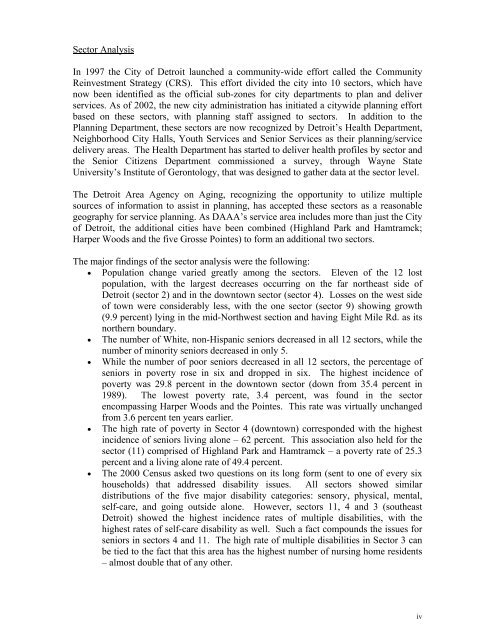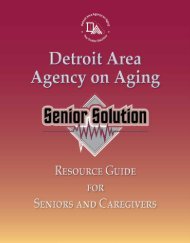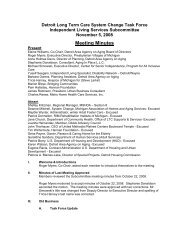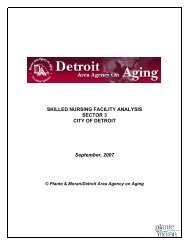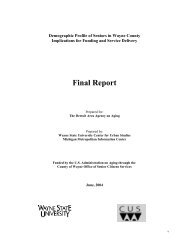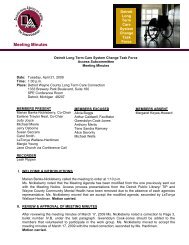Demographic Profile of Seniors in PSA 1-A - Detroit Area Agency on ...
Demographic Profile of Seniors in PSA 1-A - Detroit Area Agency on ...
Demographic Profile of Seniors in PSA 1-A - Detroit Area Agency on ...
You also want an ePaper? Increase the reach of your titles
YUMPU automatically turns print PDFs into web optimized ePapers that Google loves.
Sector Analysis<br />
In 1997 the City <str<strong>on</strong>g>of</str<strong>on</strong>g> <str<strong>on</strong>g>Detroit</str<strong>on</strong>g> launched a community-wide effort called the Community<br />
Re<str<strong>on</strong>g>in</str<strong>on</strong>g>vestment Strategy (CRS). This effort divided the city <str<strong>on</strong>g>in</str<strong>on</strong>g>to 10 sectors, which have<br />
now been identified as the <str<strong>on</strong>g>of</str<strong>on</strong>g>ficial sub-z<strong>on</strong>es for city departments to plan and deliver<br />
services. As <str<strong>on</strong>g>of</str<strong>on</strong>g> 2002, the new city adm<str<strong>on</strong>g>in</str<strong>on</strong>g>istrati<strong>on</strong> has <str<strong>on</strong>g>in</str<strong>on</strong>g>itiated a citywide plann<str<strong>on</strong>g>in</str<strong>on</strong>g>g effort<br />
based <strong>on</strong> these sectors, with plann<str<strong>on</strong>g>in</str<strong>on</strong>g>g staff assigned to sectors. In additi<strong>on</strong> to the<br />
Plann<str<strong>on</strong>g>in</str<strong>on</strong>g>g Department, these sectors are now recognized by <str<strong>on</strong>g>Detroit</str<strong>on</strong>g>’s Health Department,<br />
Neighborhood City Halls, Youth Services and Senior Services as their plann<str<strong>on</strong>g>in</str<strong>on</strong>g>g/service<br />
delivery areas. The Health Department has started to deliver health pr<str<strong>on</strong>g>of</str<strong>on</strong>g>iles by sector and<br />
the Senior Citizens Department commissi<strong>on</strong>ed a survey, through Wayne State<br />
University’s Institute <str<strong>on</strong>g>of</str<strong>on</strong>g> Ger<strong>on</strong>tology, that was designed to gather data at the sector level.<br />
The <str<strong>on</strong>g>Detroit</str<strong>on</strong>g> <str<strong>on</strong>g>Area</str<strong>on</strong>g> <str<strong>on</strong>g>Agency</str<strong>on</strong>g> <strong>on</strong> Ag<str<strong>on</strong>g>in</str<strong>on</strong>g>g, recogniz<str<strong>on</strong>g>in</str<strong>on</strong>g>g the opportunity to utilize multiple<br />
sources <str<strong>on</strong>g>of</str<strong>on</strong>g> <str<strong>on</strong>g>in</str<strong>on</strong>g>formati<strong>on</strong> to assist <str<strong>on</strong>g>in</str<strong>on</strong>g> plann<str<strong>on</strong>g>in</str<strong>on</strong>g>g, has accepted these sectors as a reas<strong>on</strong>able<br />
geography for service plann<str<strong>on</strong>g>in</str<strong>on</strong>g>g. As DAAA’s service area <str<strong>on</strong>g>in</str<strong>on</strong>g>cludes more than just the City<br />
<str<strong>on</strong>g>of</str<strong>on</strong>g> <str<strong>on</strong>g>Detroit</str<strong>on</strong>g>, the additi<strong>on</strong>al cities have been comb<str<strong>on</strong>g>in</str<strong>on</strong>g>ed (Highland Park and Hamtramck;<br />
Harper Woods and the five Grosse Po<str<strong>on</strong>g>in</str<strong>on</strong>g>tes) to form an additi<strong>on</strong>al two sectors.<br />
The major f<str<strong>on</strong>g>in</str<strong>on</strong>g>d<str<strong>on</strong>g>in</str<strong>on</strong>g>gs <str<strong>on</strong>g>of</str<strong>on</strong>g> the sector analysis were the follow<str<strong>on</strong>g>in</str<strong>on</strong>g>g:<br />
• Populati<strong>on</strong> change varied greatly am<strong>on</strong>g the sectors. Eleven <str<strong>on</strong>g>of</str<strong>on</strong>g> the 12 lost<br />
populati<strong>on</strong>, with the largest decreases occurr<str<strong>on</strong>g>in</str<strong>on</strong>g>g <strong>on</strong> the far northeast side <str<strong>on</strong>g>of</str<strong>on</strong>g><br />
<str<strong>on</strong>g>Detroit</str<strong>on</strong>g> (sector 2) and <str<strong>on</strong>g>in</str<strong>on</strong>g> the downtown sector (sector 4). Losses <strong>on</strong> the west side<br />
<str<strong>on</strong>g>of</str<strong>on</strong>g> town were c<strong>on</strong>siderably less, with the <strong>on</strong>e sector (sector 9) show<str<strong>on</strong>g>in</str<strong>on</strong>g>g growth<br />
(9.9 percent) ly<str<strong>on</strong>g>in</str<strong>on</strong>g>g <str<strong>on</strong>g>in</str<strong>on</strong>g> the mid-Northwest secti<strong>on</strong> and hav<str<strong>on</strong>g>in</str<strong>on</strong>g>g Eight Mile Rd. as its<br />
northern boundary.<br />
• The number <str<strong>on</strong>g>of</str<strong>on</strong>g> White, n<strong>on</strong>-Hispanic seniors decreased <str<strong>on</strong>g>in</str<strong>on</strong>g> all 12 sectors, while the<br />
number <str<strong>on</strong>g>of</str<strong>on</strong>g> m<str<strong>on</strong>g>in</str<strong>on</strong>g>ority seniors decreased <str<strong>on</strong>g>in</str<strong>on</strong>g> <strong>on</strong>ly 5.<br />
• While the number <str<strong>on</strong>g>of</str<strong>on</strong>g> poor seniors decreased <str<strong>on</strong>g>in</str<strong>on</strong>g> all 12 sectors, the percentage <str<strong>on</strong>g>of</str<strong>on</strong>g><br />
seniors <str<strong>on</strong>g>in</str<strong>on</strong>g> poverty rose <str<strong>on</strong>g>in</str<strong>on</strong>g> six and dropped <str<strong>on</strong>g>in</str<strong>on</strong>g> six. The highest <str<strong>on</strong>g>in</str<strong>on</strong>g>cidence <str<strong>on</strong>g>of</str<strong>on</strong>g><br />
poverty was 29.8 percent <str<strong>on</strong>g>in</str<strong>on</strong>g> the downtown sector (down from 35.4 percent <str<strong>on</strong>g>in</str<strong>on</strong>g><br />
1989). The lowest poverty rate, 3.4 percent, was found <str<strong>on</strong>g>in</str<strong>on</strong>g> the sector<br />
encompass<str<strong>on</strong>g>in</str<strong>on</strong>g>g Harper Woods and the Po<str<strong>on</strong>g>in</str<strong>on</strong>g>tes. This rate was virtually unchanged<br />
from 3.6 percent ten years earlier.<br />
• The high rate <str<strong>on</strong>g>of</str<strong>on</strong>g> poverty <str<strong>on</strong>g>in</str<strong>on</strong>g> Sector 4 (downtown) corresp<strong>on</strong>ded with the highest<br />
<str<strong>on</strong>g>in</str<strong>on</strong>g>cidence <str<strong>on</strong>g>of</str<strong>on</strong>g> seniors liv<str<strong>on</strong>g>in</str<strong>on</strong>g>g al<strong>on</strong>e – 62 percent. This associati<strong>on</strong> also held for the<br />
sector (11) comprised <str<strong>on</strong>g>of</str<strong>on</strong>g> Highland Park and Hamtramck – a poverty rate <str<strong>on</strong>g>of</str<strong>on</strong>g> 25.3<br />
percent and a liv<str<strong>on</strong>g>in</str<strong>on</strong>g>g al<strong>on</strong>e rate <str<strong>on</strong>g>of</str<strong>on</strong>g> 49.4 percent.<br />
• The 2000 Census asked two questi<strong>on</strong>s <strong>on</strong> its l<strong>on</strong>g form (sent to <strong>on</strong>e <str<strong>on</strong>g>of</str<strong>on</strong>g> every six<br />
households) that addressed disability issues. All sectors showed similar<br />
distributi<strong>on</strong>s <str<strong>on</strong>g>of</str<strong>on</strong>g> the five major disability categories: sensory, physical, mental,<br />
self-care, and go<str<strong>on</strong>g>in</str<strong>on</strong>g>g outside al<strong>on</strong>e. However, sectors 11, 4 and 3 (southeast<br />
<str<strong>on</strong>g>Detroit</str<strong>on</strong>g>) showed the highest <str<strong>on</strong>g>in</str<strong>on</strong>g>cidence rates <str<strong>on</strong>g>of</str<strong>on</strong>g> multiple disabilities, with the<br />
highest rates <str<strong>on</strong>g>of</str<strong>on</strong>g> self-care disability as well. Such a fact compounds the issues for<br />
seniors <str<strong>on</strong>g>in</str<strong>on</strong>g> sectors 4 and 11. The high rate <str<strong>on</strong>g>of</str<strong>on</strong>g> multiple disabilities <str<strong>on</strong>g>in</str<strong>on</strong>g> Sector 3 can<br />
be tied to the fact that this area has the highest number <str<strong>on</strong>g>of</str<strong>on</strong>g> nurs<str<strong>on</strong>g>in</str<strong>on</strong>g>g home residents<br />
– almost double that <str<strong>on</strong>g>of</str<strong>on</strong>g> any other.<br />
iv


